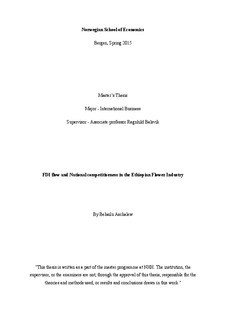| dc.description.abstract | Over the past few decades, relocation of global flower production from traditional hubs in Western Europe and North America towards developing countries has become recurrent in the global flower industry. In line with this trend, Ethiopia has emerged as one of the hot destination for flower production. Although flower production as a commercial undertaking is relatively new to its economy, the country came to be one of the main global suppliers. In about a decade time, the country has becomes the second largest exporter in Africa and the fifth largest non-EU exporter to the EU flower market. In view of this development, this study examines FDI flow and competitiveness in the country’s flower industry by using Porter’s (1990) diamond as analytical framework. The study employs a mixture of primary and secondary data sources including interview and survey conducted with flower farm managers/owners, and governmental and industry experts; and analysis of policy document, trade and other economic data from government organisations; United Nation Conference on Trade and Development (UNCTAD) and the Ethiopian Horticultural Producers and Exporters Association. The analysis uncovered the instrumental role FDI played for the emergence of the Ethiopian flower industry into the global scene. Although the export value has been growing over the years, over the past few years the sector’s performance has been patchy as it not only lagged behind expectation but also showed a mixed trend. In addition, interesting inconsistency regarding the export value reported by the Ethiopian authorities and the value reported by the importing countries has been uncovered. With respect to the sector’s competitiveness, the analysis revealed that the friendly investment climate in combination with the favourable factor conditions is the major catalysts in making the sector globally competitive. The other determinants of competitiveness i.e. related and supporting industries, demand condition and firm structure and rivalry are found to be weak. | nb_NO |
